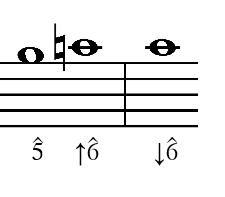Melodic minor scales – Repeat the Top Note?

Melodic Minor Scales - Repeat or Not to Repeat the Top Note, that is the question.
Melodic Minor Scales - Why do we have to repeat the top note when writing an ascending and descending Melodic Minor Scale starting on the Submediant or the Leading Note?
As a young Teacher, I was terrified when a student asked me a “Why” question.
I was afraid that if I said “I don’t know”, they would think that I was dumb. Now, nothing makes me happier then when a student asks “Why” and I don’t know the answer.
Why? Because I get to learn something new! In Theory, there is always a theoretic or pedagogic reason to every “Why”. And I love putting on my Sherlock Holmes hat to discover it.
Please share your theory workbook "Why" moment, or questions on Melodic Minor Scales at the bottom of the blog…
 My student Liam is preparing for his Advanced Rudiments Theory Exam. He loves to ask “Why?” questions as he has a passion for knowledge.
My student Liam is preparing for his Advanced Rudiments Theory Exam. He loves to ask “Why?” questions as he has a passion for knowledge.
When he asked “Why do we repeat the top note in Melodic Minor Scales when it starts on the Submediant or the Leading Note, but not when it starts on the Tonic, Supertonic, Mediant, Subdominant or Dominant?”, I knew the answer! (SCORE!)
When writing a Major, Harmonic Minor or Melodic Minor Scale ascending and descending, if the bottom note is the SAME NOTE as the top note, it is NOT repeated at the top of the descending scale. Why? Because it is the SAME note.
Liam asked me “Why do we have to repeat the Submediant and Leading Note when writing a Melodic Minor Scale when they are the same note?” Because they are NOT the same note.
MELODIC MINOR SCALES
On Page 21 in the Advanced Rudiments Workbook, we explain how to write Melodic Minor Scales beginning on the Submediant or Leading Note.

If your student plays a C natural instead of a C flat, you would correct them. Why? Because they are not the same note.
In all other scales, the starting note is not repeated when writing the descending scale because it is the same note.

- Melodic Minor Scales – So why do we have to repeat the top note when writing an ascending and descending Melodic Minor Scale starting on the Submediant or the Leading Note? Because it is not the same note.
Have you ever been asked a “Why” question from a student and you didn’t know the answer? Don’t panic – it is okay to say “Good question – and at your next lesson, I will have the answer for you.”
I used to feel embarrassed and ashamed when I didn’t know the answer immediately to every “Why” question. And then I realized that if I actually knew everything, I would miss out on the adventure of exploring and discovering new theoretic and pedagogic concepts.
Don’t be afraid or embarrassed to share your “Why” questions below. It will give me the opportunity to keep on learning…and I love to put on my Sherlock Holmes hat!
P.S. Join the conversation – Enter your music theory "WHY" questions or comments on Melodic Minor Scales below.

Ultimate Music Theory Certification Elite Educator Program - Online Teacher Training to Elevate Your Income, Impact Your Teaching and Grow Your Expert Music Teaching Business. Get Certified!
Click HERE to discover what you will learn in the Ultimate Music Theory Certification Course. Your professional development Online Teacher Training starts here!
Keep on Learning... With a Smile and a Song!
Shelagh McKibbon-U'Ren


Hi Shelagh,
Why are there perfect 4th, 5th and 8th and not major 4th, 5th and octaves.
Sincerely,
Kathy Warren
Good question Kathy . . . I think it has to do with the physics of how the sound waves come together but can never explain it beyond this point. It’s time for Shelagh to put on her physics cap!!??
WOW Kathy! That is a GREAT question! There are actual “scientific reasonings” behind the Perfect Intervals versus the Major/minor Intervals. Here are 3 (of many) explanations “in a nut shell”:
1) The most important notes in a “Key” are the Tonic, followed by the Dominant and then the Subdominant. We consider the intervals that use those notes to be “Perfect”. In music, Perfect intervals are more stable, and do not “change” or vary as much as the Major/minor relationships of the 2nd, 3rd, 6th and 7th. In Harmony, using an Augmented Interval (especially the Tritone – the Augmented 4/Diminished 5) is a big “no-no”.
2) There is a difference in the sound frequencies of Perfect versus Major/minor Intervals. The ratio of sound for the Perfect Intervals is a simple whole number and therefore has a more “pleasing” sound than the ratio of sound for the 2nd, 3rd, 6th and 7th. (In “layman’s terms” – the 1st, 4th, 5th and 8th actually do sound nicer than the 2nd, 3rd, 6th and 7th.)
3) Pythagorus, the Greek Philosopher and Teacher, basically established the chromatic octave and stated that the intervals of the P1, P4, P5 and P8 were the most pleasing, the most consonant. The Supertonic, Mediant, Submediant and Leading Note (or Subtonic) notes were more dissonant. Pythagorus was born in 570 BC, and had a huge influence on music and music theory.
I like to tell my students that Pythagorus established “rules” hundreds of years before Bach, and then Bach perfected them. So, “it is so” because Pythagorus said so, and Bach proved it. (*grin*)
Does this answer your Why? in a way that you can tell your students? I hope so! Shelagh
Here’s what I was taught: A perfect interval is one in which the upper note is in the Major scale of the lower note, and the lower note is in the Major scale of the upper note. (C – G, P5; C is in the G scale, G is in the C scale). A Major interval is one in which the upper note is in the Major scale of the lower note, but the lower note is not in the Major scale of the upper note. (C – E, M3; E is in the C scale, C is not in the E scale.)
And yes! That would be reason #4! Well done! A Perfect Interval is the only interval when inverted remains a Perfect Interval for that exact reason. Thanks Deanne!
Isn’t it an awesome feeling to “know” the answer to a why question Aimee?! I will readily admit that the first time a student asked me that question (back when I was a “young” teacher…when dinosaurs ruled the earth…LOL) I didn’t know the answer. This was before Google too, so I had to do a lot of library research to actually find the answer. When I was thinking of topics to write about, this “why” question was the first on my list as it was the first “why” question that really stumped me for an answer. Shelagh
Knowing is different than teaching. I love how musical concepts are made clear so that we, as teachers, can learn how to put our knowledge into concise and understandable explanations. Thank you Shelagh!!
That’s great question Kathy! I asked the exact same question of my teacher. I love that one. Pythagorus rules! I also tell my students that when you invert a Perfect 5 it becomes a Perfect 4. When you invert a Perfect 4 it becomes a Perfect 5. Same goes for the Perfect 1 and Perfect 8. When you invert a Major interval it becomes minor. So that’s why it’s not Perfect. Shelagh may add to this too. 🙂
I seem to remember from music history classes light years ago that certain intervals and modes were thought to invoke certain moods. Some were even blamed for making people evil or crazy. (such as the tritone) Young people were not supposed to be “exposed” to certain modes, do to the effect those sounds had on their moods. Then the church modes were given different meanings as well. All these attitudes probably had a beginning with good ol’ Pythagoras and physics. The good Lord certainly made things in an orderly fashion. I like having my students listen to the intervals and then seeing and listening to their reactions. They love hearing about the historical attitudes toward the tritone. “Crazy, man!”
During the Middle Ages, Gregorian chant was sung in Unison. When harmonies were added, the ONLY intervals which were allowed by the church were parallel fifths and fourths. This is because music on earth was thought to be a representation of the perfection of God. Fourths and Fifths are perfect 2:3 ratios. Thirds and Sixths were considered unpleasing to the ear, and were actually forbidden by the Catholic Church which sort of makes sense when you consider that a system of equal temperment tuning hadn’t been adopted yet, and seconds, thirds, sixths and sevenths were subject to the problem of the nasty “Pythagorean comma.” Howard Goodall explains this really well in his episode 2 of his documentary, “Big Bangs,” which is available on DVD from the Alberta Piano Teachers Association lending library.